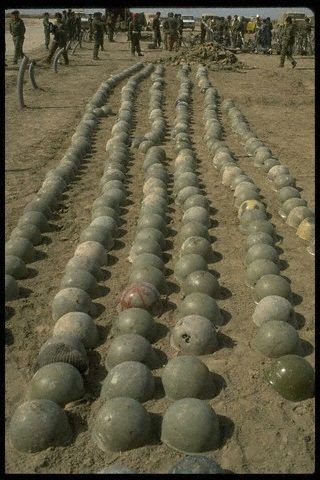
[This post is based on “Iranian Casualties in the Iran-Iraq War: A Reappraisal,” by H. W. Beuttel, originally published in the December 1997 edition of the International TNDM Newsletter.]
Posts in this series:
Iranian Casualties in the Iran-Iraq War: A Reappraisal
Iranian Missing In Action From The Iran-Iraq War
Iranian Prisoners of War From The Iran-Iraq War
The “Missing” Iranian Prisoners of War From The Iran-Iraq War
Iranian Killed And Died Of Wounds In The Iran-Iraq War
Iranian Wounded In Action In The Iran-Iraq War
Iranian Chemical Casualties In The Iran-Iraq War
Iranian Civil Casualties In The Iran-Iraq War
A Summary Estimate Of Iranian Casualties In The Iran-Iraq War
It is the opinion of this author that, aside from the 400 expatriates Iraq admitted, that the “5,000” Iranian PoW and “20,000 PoW/MIA” still unaccounted for [as of December 1997] will be shown to be KIA (dead on the battlefield or died in captivity) as recovery operations proceed (20 more were delivered to Iran in June 1997 and another 15 in August). The alternate possibility is that some or most of these personnel now serve in the NLA or other Iraqi supported resistance groups and their identities and existence are concealed for this reason. There is no real evidence that such a large number of living Iranian PoWs are still being held by Iraq. Another chilling possibility recently raised is that some Iranian POWs may have disappeared into the Iraqi biological weapons programs as human guinea pigs.”[73]
[Authors note: As this article went to press I uncovered a small piece of information from 1988. In reference to some of the Iranian MIAs being defectors to the Iraqi-sponsored NLA, the Iranians estimated that as many as 3,000 of their troops may have defected while PoWs in Iraq. They have never mentioned this since. Also 136 Iranian soldiers were arrested and shot for desertion.]
The continued Iranian insistence on 5,000 possible remaining PoWs may also be related to the 6,000 missing declared dead at family request without recovery of a body. In an interesting turn to usual practice, the families seem to have given up hope before the government has lost interest.
Further complicating the matter, Iran seems to have lost control of its accounting procedures. Originally listing 60,711 “missing” in 1988, this increased to 72,753 estimated MIA by 1995. If we combine the 39,048 released PoWs with 72,753 estimated MIA, Iran actually had some 111,801 PoW/MIA during the war or 84% more than they first thought. If there are 5,000 Iranian PoWs still held by Iraq then the total would be 116,801 or 92% higher than estimated.
The answer to this poor accounting probably lies in the overall organization for combat employed by Iranian forces during the war. In addition to the regular army and Pasdaran, Iran employed a third component called the Baseej. The Baseej al Mostafazim (Mobilization of the Oppressed) was founded as a wartime expedient to augment the IRGC and formally placed under their control in January 1981. Baseej formations comprised 300-man battalions divided into 100-man companies with 22-man platoons armed with light weapons.[74] Their functions were IRGC reinforcement in the war. Baseej units fought extensively in the War of Sacred Defense (1980-88). However, their availability was only episodic as their tour of duty was normally only three months, usually from January to March. At this time most Baseej were rural peasants, often very young (some only 10) or very old and illiterate, who had to return for spring planting and fall harvests. As a result their training was rudimentary, often as little as two weeks of small arms and hand grenade practice. It was the Baseej who were given plastic keys to hang around their necks with the promise these would unlock the gates of paradise if they were killed in action.[75] As many as two million Baseej forces saw combat in the imposed war with Iraq.[76]
When the Iranian government offered its original tally of dead and missing in 1988 the Baseej losses were not mentioned separately and assumed to fall under the category of Pasdaran. It was only after the war when most (if not all) Iranian PoWs had been released and the magnitude of the MIA issue became evident that Iran realized it had suffered far more losses than originally thought. It is likely the degree of Baseej unit administration and accountability was far below regular army or established Pasdaran formations. Given the episodic nature of their participation, widespread personnel illiteracy and their poor level of training (and the fact they were used as temporary human “fill” for Pasdaran formations), it is unlikely that unit returns were maintained in anything like a proper or organized manner.
This author believes that the bulk of the additional true MIAs claimed since the end of the war are represented by primarily Baseej fallen who were simply not originally accounted for in established Pasdaran or regular army unit returns. Baseej units made up to 40% of Iranian force strength during the war. The 73,000 now-claimed missing (and presumed dead) of the war represent 38% of the total known and presumed combat dead (circa 188,000—see below). This is too close to be accidental.
Mr Beuttel, a former U.S. Army intelligence officer, was employed as a military analyst by Boeing Research & Development at the time of original publication. The views and opinions expressed in this article do not necessarily reflect those of The Boeing Company.
